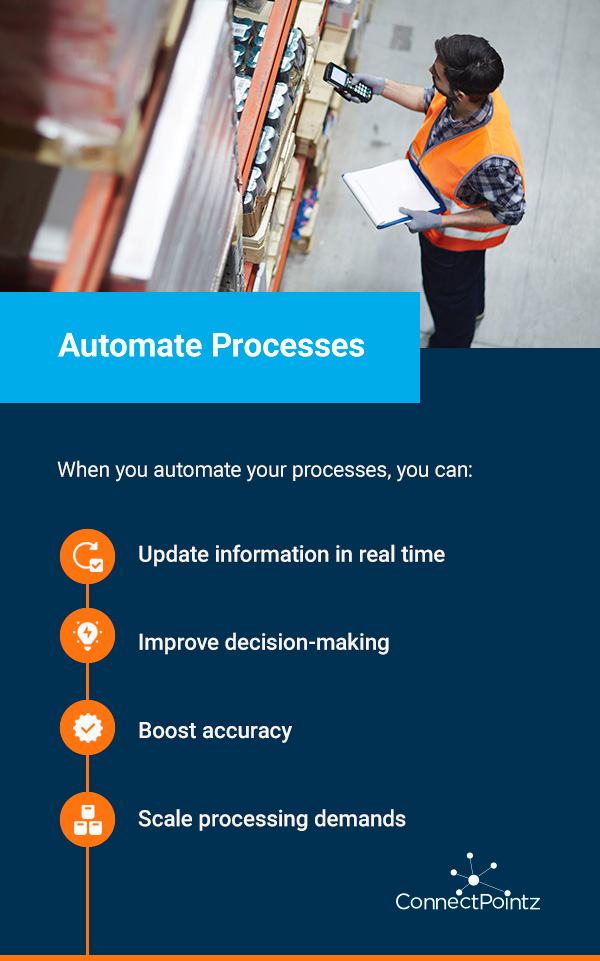
In today's shopping landscape, consumers have a wealth of options, from where they buy a product to when they get it to how they contact customer service. The businesses that stand out are the ones that have thrived in omnichannel environments. These companies understand their varied markets and have strong digital solutions in place to automate and manage the different data sources involved.
This kind of sales channel management used to be difficult, but today's technology has made it more accessible than ever. In fact, companies that fail to adopt omnichannel strategies often lag behind the competition. It's also a crucial part of growing a business, allowing you to branch out smoothly and build a strong reputation. If you aren't using multiple channels for sales and inventory management, you're leaving money on the table.
Managing e-commerce platforms can seem complex, but we've put together a guide to managing multichannel sales management across online stores, marketplaces and brick-and-mortar locations.
What Is a Sales Channel Strategy?
Before we dive into managing multiple sales channels, let's define what a sales channel strategy actually is. A sales channel refers to the manner in which you sell your products. Usually, channel sales involve a partnership with another company or multiple companies, such as distributors, affiliates and retailers.
Typically, consumer sales fall under one of three channels:
- E-commerce marketplaces: Businesses can sell their products through third-party marketplaces like Amazon, eBay and Etsy.
- Individual e-commerce stores: Companies can sell products on their own through their websites.
- Brick-and-mortar stores: Distributors can buy products in bulk and sell them through brick-and-mortar locations, such as Target or Walmart.
Additionally, you can define a sales channel by how the consumer buys the product — online, in-store or over the phone — or how they receive it — if it gets delivered curbside, shipped to their home or held at a pickup counter. Managing multiple sales channels often overlaps with channels in other areas, like marketing and distribution. For example, an omnichannel sales approach might involve listing items on several websites, which requires numerous marketing and communications approaches.
Today's consumers expect cohesive experiences across the board, and having effective multichannel sales management is essential for meeting those demands.
Creating a Multichannel Sales Strategy
Of course, creating a multichannel sales strategy isn't as simple as listing your items on a marketplace and calling it a day. How do you divide your stock among the different channels? How will they affect your customer service capabilities? How will your audiences differ on the platforms? Successfully managing multiple sales channels calls for some preparation.
1. Choose the Right Sales Channels
The first step is to make sure your sales channels are appropriate for your needs. Signing up for every channel possible is simply going to add complexity and may not pay off in the way you expect. Consider elements like:
- Profitability: Look at how much money you can expect from different channels. Some will have exorbitant fees and taxes, while others might have restrictive policies that bar you from selling in the way you want. Spend some time analyzing your potential profits from a channel and determine whether it'd be worthwhile for your organization.
- Audience behavior: Think about how your buyers like to shop. Do they prefer buying online and having the item shipped to them or do they like to see and feel it before they buy? Do they prefer paying directly with a credit card or would they rather use PayPal? How do they feel about seller trustworthiness? Conduct some research and look for sales channels that appeal to their needs.
- Administrative requirements: Of course, you'll want as little busywork as possible. Consider how much extra time the platform will require, and make sure your team can handle multiple sales channels. Keep in mind that most processes can be automated with the right tools, so you don't necessarily need a large team to take on multiple sales channels.
- Cash flow: Take a look at how the channel processes payments. Some might pay out funds on a certain date, while others might pay you immediately. See which is best for your financial needs.
- Trust: Is the platform one your customers will trust? This is a big selling point for many large marketplaces like Amazon and Etsy. They're well-established with protections for buyers if something goes wrong. On the other hand, individual seller websites can seem risky. Consider how important trust is to your buyers and whether you can cultivate trust on your chosen channel.
- Alignment: Channels can vary widely, and you should only sell on channels that align with your business goals. If you sell makeup, listing it on a sporting goods website won't be the best choice. If you're trying to appeal to a younger crowd, you may want to avoid the channel with a large percentage of older adult buyers. Look for a platform that shares your company's values and can meet its needs.
- Growth: Make sure your chosen channel can accommodate growth. If you're working with manual processes, managing a complex platform could outpace your capabilities as you grow. If your channels support automation, you have the freedom to scale up as needed.

2. Manage Your Inventory
One of the most difficult parts of adopting an omnichannel approach is understanding inventory demands.
Say you have 20 shirts and four sales channels, and you allocate five shirts to each channel. One of them sells out right away, so shoppers start receiving out-of-stock notices — but you still have 15 shirts left to sell. By the time you update availability, you've already started losing customers. Smart inventory management can help you avoid these problems through sales channel integrations, which offer real-time updates across different channels.
Inventory management systems are an essential part of adopting a multichannel approach. While you could technically use manual processes, they'd be incredibly complex and take up a hefty amount of time. You'd likely struggle to keep up with orders and deal with overselling and underselling.
On the other hand, if you're prepared for multichannel inventory management, you can quickly and easily adapt to changing stock levels and evolving pricing. To get there, you'll need a cross-platform inventory management solution that integrates with all of your sales channels and other relevant parties, like shipping companies or third-party logistics (3PL) providers.
A connected system can also allow you to offer customers more convenience, such as the ability to return an online purchase in a brick-and-mortar store or buy online and pick up in-store.
3. Consider Your Marketing Strategies
Different channels attract different people. Your marketing efforts will need to adapt. The same strategy that works well on Amazon might not appeal to your in-store buyers. On Amazon, you might want to focus on providing details and differentiating your product from the competition, while an Etsy listing could benefit from content that highlights the item's creative side. Lay out the audiences you'll be targeting on each channel and how your strategy will change to reach them.
Be sure to fold your new sales channels into your social media posts. Spread the word and post links to your products so people know exactly where they can buy them. Connect your channels to your social media networks, and consider hiring influencers to advertise. Don't forget to sell your new channels by telling people about additional benefits, like in-store returns or package tracking.

4. Offer Strong Customer Service
To support your multichannel sales approach, you'll need omnichannel communications to deliver stellar customer service. Consumers expect snappy responses across multiple platforms — and they want you to get it right the first time. For many consumers, the most frustrating part of a customer service experience is an agent's inability to solve the problem.
An omnichannel approach to sales can help simplify and streamline data. It allows agents to access real-time dependable information, so they can spend less time hunting down information and more time providing a great customer experience. If your sales channels and inventory are integrated, you can also offer more reliable and transparent services, so customers see you as a trustworthy brand.
Part of strengthening multiple sales channels is ensuring customers can make purchases and receive support in multiple ways. Your customer service approach should offer different communication channels, like instant messenger, email, social media and phone calls. Whether your customers want to buy online or in-store, you'll want to provide solutions that fit their preferences.
5. Analyze Your Data
Omnichannel sales involve considerable experimentation. Some markets will perform better than others, and how you handle your inventory, marketing and other aspects will determine your success. To understand where to make changes and tweak your strategy, you'll need to collect and analyze data. An integrated system will help here, allowing you to bring data from multiple sources into one place.
Look at information like:
- Where your customers are coming from: Are they reaching you from search results, social media, referrals or somewhere else? This information can help you narrow down your audience and understand how successful your marketing strategies are.
- What items are selling the best: Knowing your top sellers can help you forecast inventory demands and adjust marketing campaigns.
- How many purchases are made every hour, day or week: These numbers can help with forecasting and allow you to better understand your product flow.
- Customer satisfaction ratings: Look for patterns that clue you in to where you can make changes. If you need more insights, send out surveys and ask for reviews. Most customers are happy to tell you where you can improve.
Data analysis is a continuous process. Make sure you review metrics often and use them wisely.

6. Automate Processes
Multichannel sales processes are near impossible without automation. You need to juggle an array of different platforms and orders and set them up to pull from the same inventory. Keeping up with these processes manually would take a significant amount of labor — too much for most companies to manage.
You'll need some level of automation to cover the basics, but you can also go above and beyond to improve your operation. The best software for multiple sales channel management is one that helps you streamline processes across different systems.
When you automate your processes, you can:
- Update information in real time: Let's return to the example of stock information not updating in real time and giving out-of-stock notices to customers. Manual processes would require personnel to stay on top of things 24/7. Many companies don't have the staff for that, nor would they want to use precious employee time on easily automatable work. Automating these updates ensures dependable stock counts at all times.
- Improve decision-making: Automation can also help you make better decisions in less time. Consider shipping comparisons. Manually comparing shipping options for every item would be incredibly time-consuming. Instead, you can automate your system to choose the right shipping cost and speed based on each package's needs. You can also boost decision-making capabilities with hands-off data collection and analysis and by helping managers reduce the time spent on administrative workloads.
- Boost accuracy: When computers handle data movement, human error is eliminated. In areas like accounting and quality control, accuracy is especially important, particularly for organizations in sensitive industries such as pharmaceuticals. Automating the transfer of data standardizes it and provides consistent, reliable records.
- Scale processing demands: Do you have a busy season coming up? Are you expanding your business? With automation, it's not a problem. There's no need to hire and train new staff or worry about meeting administrative demands. Your automated processes can keep up with more orders and tasks.
To successfully automate your sales processes, you'll need to set yourself up for successful integration.
7. Integrate Your Sales Channels
An omnichannel sales approach isn't about just having multiple sales channels. It's about bringing them all together in a cohesive, efficient sales environment. To do that, you'll need to link them all up. The best platform for managing multiple sales channels should centralize your data in one place, so you can access and manage transactions from all of your sales channels conveniently and quickly.
In addition to sales, you'll want to integrate other systems you use, like your inventory management system (IMS), customer relationship management (CRM) system or accounting platform. By linking your systems, you can ensure they communicate seamlessly, allowing employees to access the right information and work quickly to provide a top-tier experience for your customers.
Syncing up your sales channels with each other and other systems keeps your entire operation up-to-date and dependable, two critical components for the modern e-commerce landscape.
Simplify Multichannel Sales With ConnectPointz
Whether you already manage multiple sales channels or are looking to branch out, ConnectPointz can help. Our comprehensive integration solutions can help you centralize just about every system you use, from retailer and 3PL platforms to shipping and inventory tools. Automate and streamline your processes according to business needs and expand your reach with smooth multichannel sales.
ConnectPointz fits businesses of all shapes and sizes with affordable and powerful solutions and is one of the best platforms for managing multiple online sales channels. To learn more about how we can help your organization grow, please reach out to a representative today!










































